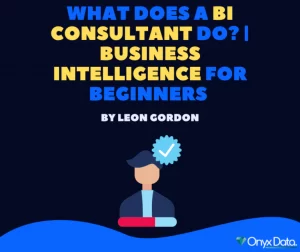
Introduction
The Business Intelligence consultant, often called BI consultant, provides expert advice, analysis, and solutions. They aid new and
established firms to grow and grow. They are in charge of improving the internal processes of a company through consulting and data analysis looking to achieve a competitive advantage.
What are their job and duties? How can business intelligence consultants deal with issues? The analysis of data described in this article will help discover how business consultants can use tools and technology to uncover the most recent trends and information for their companies.
History of Big Data and Business Intelligence
Big Data has been described by a few Data Management pundits (with a slight chuckle) by calling it “huge, overwhelming, and uncontrollable amounts of information.” The year 1663 was the first time John Grant had to manage “overwhelming amounts of information” and study the bubonic plague that was now sweeping across Europe. Grant utilized statistics and is recognised as being the first person to employ statistics to analyse data. At the beginning of the 1800s, statistics was broadened to encompass the gathering and analysis of data.
The rise of Big Data includes several initial stages to its inception, however dating back to 1663, it isn’t necessary for the exponential growth in the volume of data in the present. Data started to pose a problem for the U.S. Census Bureau in 1880. The bureau estimated it could take eight years to handle and process the data gathered from the 1880 census and estimated that the information gathered from the 1890 census would take longer than 10 years to process. In 1881, an employee at the bureau called Herman Hollerith created the Hollerith Tabulating Machine. The machine was influenced by punch cards used to control patterns made by the mechanical machines that weave. His machine for tabulating transformed 10 years of hard work into just three months of work.
In 1929, Fritz Pfleumer, an engineer from Austria and Germany who invented the idea of storage of data using magnetic tape. Then, during World War II (more specifically 1943), the British determined to break Nazi codes developed a machine that could find patterns in messages taken by Germans. The machine was called Colossus and could scan 5.000 characters per second, which reduced the amount of work required from weeks to a couple of hours. Colossus is also believed to be the very first computer that processed data. Two years later, in 1945, John Von Neumann published an article on The Electronic Discrete Variable Automatic Computer (EDVAC), which was the first “documented” discussion on program storage. This laid the basis for computer architecture that continues today.
In 1989, in 1989, in 1989, the British Computer Scientist named Tim Berners-Lee came up with the concept of The World Wide Web. In 1993, CERN announced that it was open to all. World Wide Web was open to all users to build and use. The concept that the Internet of Things (IoT) was assigned its official name in 1999. By 2013, the IoT had evolved to include multiple technologies, using the Internet, wireless communications, micro-electromechanical systems (MEMS), and embedded systems.
In 2005, Big Data which was not given an identifier, was named in 2005 as Big Data by Roger Mougalas. He was referring to a huge amount of data, which was difficult to handle and process using the standard tools for business intelligence that was available. Hadoop, which could handle Big Data, was created in 2005. Magnetic storage is among the most cost-effective methods to keep data. Fritz Pfleumer’s idea in 1927 of magnetic lines stripe-like was modified to a variety of formats, such as magnetic drums, magnetic tape, floppy disks, magnetic drums, and even HDD drives.
Cloud Data Storage has become extremely popular in recent years. The first, truly Cloud Data Storage was created in 1983 when CompuServe gave its customers 128K of private and secure storage space. Then, in 1999, Salesforce offered Software-as-a-service (SaaS) from their website. Big Data is revolutionising entire industries and changing the way we live and act. It’s the result of the information age and is changing the way people exercise, create music, or work.
Analytics is an approach that has started in 1663 during the year 1663. John Grant dealt with “overwhelming amounts of information,” using statistics to analyse bubonic plague. In 2017, more than 2800 experts in Business Intelligence were surveyed, and they predicted Data Discovery and Data Visualisation to be the most significant aspect to be watching. The term “data visualisation” refers to the process of turning information into visualisations. Visualisation is one of the methods which makes use of visual communication (think Infographics). It’s description data transformed into a diagrammatic format that contains variables, changes, and fluctuations. Human brains can recognise visual patterns with great efficiency.
Therefore, visualisation models are growing in popularity as a way of gaining insights into Big Data.
Benefits of Business Intelligence
A robust BI solution can help you combine complex data to help you make business decisions in just a few minutes. It doesn’t matter if you’re a large industry, mid-sized company, or new start-up company. You can take advantage of BI to turn information from your business into potential. Are you interested in how you can benefit from this BI process? Let’s look at the advantages of business intelligence.
Increase Productivity in Business
The productivity of organisations is often left out of the equation in the rush to be at the top of heap. But, with the right tools for BI, you will be able to meet your goals quantitatively, such as monthly sales or time-to-delivery goals and monitor your company’s performance every day.
- Explore internal patterns and gain a better understanding of the processes that aren’t working.
- You will receive feedback on weaknesses in your company.
- Find cost-saving opportunities within your business
- Track the inventory you have and alter your production to increase profit margins
- Discover patterns in the industry and gain insight, increase efficiency in forecasting results
Improve Accessibility to Crucial Information
With the enormous quantity of data created every second, finding accurate information at the right time to make an important business decision isn’t easy. BI systems include visualisation tools that provide insight into the past data and real-time updated forecasts, trends, and other information.
- Convert, merge, and report information using stunning graphics
- Get vital information via screens on smartphones and tablets
- Instant access to key business metrics relating to marketing and sales
- Access vital information from huge documents at lightning-fast speed
- Note all changes and decide on the most efficient method for you. It’s a matter of time.
Boost ROI
When companies focus on matters that don’t align with their corporate strategy and strategy, they’ll be held accountable for massive costs. The BI platform permits users to develop KPIs and metrics that align with the corporate strategy, providing the necessary transparency into your company’s performance and the ROI.
- Make sure you are accountable by aligning your actions and outcomes with the objectives of your strategic plan.
- Look for areas where cost savings could be made and increase efficiency within the company.
- Use various dashboards to improve the visibility of the inventory and enhance the supply chain’s decision-making.
- Review the manufacturing process and collect the data needed to evaluate the impact of production and productivity on each.
- Enhance the efficiency of the production line on all floors of the workshop
Strategic Decision-Making Based on The Fuel
Making business-related choices based on intuition may be dangerous; it’s best to do them with analysis. BI software allows you to gather data, create and analyse using tools for analysis.
- Discover actionable insights with the analysis of data from various departments within the company, including sales marketing via social media, and various other digital initiatives
- Reduce the time you spend making reports, and devote more time analysing possible outcomes, and making business-related choices
- Reduce the amount and time involved in preparing reports that are current and concentrate on analyzing results and making more profitable choices
- Establish your company’s foundation for managing your team more effectively by making quicker, more informed decisions that are at the top of the line
Eliminate All Trash
Suppose you’re looking to attain the success you want in your business. In that case, it’s important to first eliminate waste or anything that’s not adding value to the business—systems for BI aid in identifying areas of waste and can help to improve your bottom line.
- Get a better comprehension of the data of the company and identify areas where there is inefficiency.
- Find out the cause of the flaws so that they can be eliminated as fast as you can.
- Stay up to date on customer requirements, market trends, and business trends. Ensure that you have the best inventory levels.
- Eliminate bottlenecks in manufacturing processes, improve communication and reduce your idle hours.
- Reduce the gap in the manufacturing process and develop better forecasting techniques for the removal of work being completed
Identify Opportunities
BI systems analyse unstructured data with quantitative and qualitative metrics. They help in understanding the causes of the cause.
- Assess the strengths of your business and assess strengths and weaknesses
- Recognise markets and patterns, and respond quickly to any changes
- Review the effectiveness of the experiences of customers and competitors
- See the 360-degree perspective of possibilities for business that may be a great fit
- Make better-informed decisions and increase profits while reducing expenses.
Challenges To Business Intelligence
Business intelligence can provide a range of benefits, such as faster reporting, better efficiency in operations, and more informed strategic decision-making, just to name certain. However, implementing BI tools is typically the first obstacle that businesses must overcome before they can reap the benefits. The complexity of the implementation of BI tools depends on various factors (industry training and industry.). It is particularly challenging in managing franchises, which can be a difficult and broken organisation.
Making The Right Choice for Software
The first step in the BI introduction is to make sure you choose the correct BI software that will meet your company’s needs. It’s a daunting task due to the increasing number of choices on the BI market.
Costs of Spiraling
The BI software and tools can be costly, making getting assistance from your company for using its BI system a challenging process. However, the real price of a product isn’t only the cost of the purchase. It’s also crucial to consider additional costs associated with the process, such as training and scaling. While cost is one of the most significant issues in setting up business intelligence and addressing problems, the ideal BI solution will deliver a greater return on investment (ROI) than what was initially invested.
Training
With a clearly defined BI strategy, a lack of technical knowledge could hinder software implementation for business intelligence, making it more difficult to get purchase agreements and hinder your system from functioning at its best. Furthermore, certain BI tools won’t be used to their maximum potential if you do not have a tailored regular and consistent education. It means that you’ll get very little or no improvements in your company’s performance, and the return on investment will be low. It is, therefore, crucial to plan the best method to figure out how much training is needed in the initial phases of your venture.
Method of Identifying KPIs
For BI to succeed, you need an appropriate set of KPIs that you can utilise to measure the progress and performance of your business or franchise network. Finding the most appropriate KPIs isn’t always ascertain that firms make the mistake of following trends or using unhelpful metrics, which aren’t always relevant and could lead to poor decisions. Therefore it is essential to determine if each KPI is aligned with your company’s objectives. There isn’t always a guarantee that all KPIs are important to your business. Moreover, failing to focus on the most relevant KPIs can negatively impact your business in the future.
Complex Reporting
BI is usually very technical-specific that making it difficult to grasp and implement effectively. The IT personnel or data analysts usually access the data contained in the data warehouse and use the BI tools that are complicated to find the most important data. This makes the reporting process a long and complicated process.
The solutions Business Intelligence experts can provide
These Business Intelligence (BI) consultancy services help companies extract relevant information from their data to accelerate decision-making and improve the effectiveness of their operations. Since 2005, the Onyx Data BI experts have been helping customers implement or upgrade their BI solution.
Enterprise Business Intelligence
- 360-degree view of the business through the analysis and integration of resources, finance, sales to customers, marketing, customer sales, etc.
- Cost, income as well as investment analyses.
- The company’s performance analytics.
- Prediction and forecasting, e.g., for budget planning
Operational Business Intelligence
- Analyzing and monitoring business procedures.
- The detection of unsuitable patterns and deviations.
- Examining the causes of an impact, as well as the detection of bottlenecks.
- Forecasting and prediction of performance.
Financial Business Intelligence
- Monitoring the financial performance continuously.
- The monitoring of a business’s expenses, revenue, and profits.
- Financial risk forecasting and management.
- Budget preparation as well as formulating the long-term plans of the company.
Customer Business Intelligence
- Customer satisfaction analysis
- Value and behavior of customers and.
- Customer behavior predictive modeling, churn risk management.
Marketing And Sales Business Intelligence
- Analysis of the financial viability of services and products and portfolio optimization.
- Analyzing loyalty programs and effectiveness of marketing campaigns.
- Brand portfolio analysis and analysis of awareness of brands.
- Analyzing and optimizing the funnel for sales.
Supply Chain Business Intelligence
- Planning and forecasting demand.
- Order management optimization.
- Supply chain risk analysis and management.
Conclusion
This article discussed some of the primary advantages that business intelligence could provide to companies. What are the best methods to solve every challenge a business consultant is faced with? Onyx Data is a business intelligence firm that can provide every benefit and solution to the issues that business consultants’ issues. According to the above discussion, if you’re interested in reaping all the advantages from real-world experiences, it is recommended to visit Onyx data. We can help in every area the need for a professional in the business.
References
Bach, M. P., Čeljo, A., & Zoroja, J. (2016). Technology acceptance model for business intelligence systems: Preliminary research. Procedia Computer Science, 100, 995-1001.
Elbashir, M. Z., Collier, P. A., & Sutton, S. G. (2011). The role of organizational absorptive capacity in strategic use of business intelligence to support integrated management control systems. The Accounting Review, 86(1), 155-184.
Herschel, R. T., & Jones, N. E. (2005). Knowledge management and business intelligence: the importance of integration. Journal of knowledge management.
Nofal, M. I., & Yusof, Z. M. (2013). Integration of business intelligence and enterprise resource planning within organizations. Procedia technology, 11, 658-665.
Watson, H. J. (2009). Tutorial: business intelligence–past, present, and future. Communications of the Association for Information Systems, 25(1), 39.
Williams, S., & Williams, N. (2003). The business value of business intelligence. Business Intelligence Journal, 8, 30-39.





